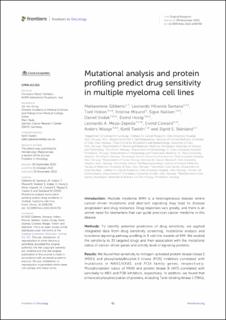| dc.contributor.author | Giliberto, Mariaserena | |
| dc.contributor.author | Miranda Santana, Leonardo | |
| dc.contributor.author | Holien, Toril | |
| dc.contributor.author | Misund, Kristine | |
| dc.contributor.author | Nakken, Sigve | |
| dc.contributor.author | Vodak, Daniel | |
| dc.contributor.author | Hovig, Eivind | |
| dc.contributor.author | Meza, Leonardo Zepeda | |
| dc.contributor.author | Coward, Eivind | |
| dc.contributor.author | Waage, Anders | |
| dc.contributor.author | Tasken, Kjetil | |
| dc.contributor.author | Skånland, Sigrid S | |
| dc.date.accessioned | 2023-02-07T12:06:35Z | |
| dc.date.available | 2023-02-07T12:06:35Z | |
| dc.date.created | 2022-12-27T12:43:29Z | |
| dc.date.issued | 2022 | |
| dc.identifier.citation | Frontiers in Oncology. 2022, 12:1040730 1-14. | en_US |
| dc.identifier.issn | 2234-943X | |
| dc.identifier.uri | https://hdl.handle.net/11250/3048873 | |
| dc.description.abstract | Introduction: Multiple myeloma (MM) is a heterogeneous disease where cancer-driver mutations and aberrant signaling may lead to disease progression and drug resistance. Drug responses vary greatly, and there is an unmet need for biomarkers that can guide precision cancer medicine in this disease.
Methods: To identify potential predictors of drug sensitivity, we applied integrated data from drug sensitivity screening, mutational analysis and functional signaling pathway profiling in 9 cell line models of MM. We studied the sensitivity to 33 targeted drugs and their association with the mutational status of cancer-driver genes and activity level of signaling proteins.
Results: We found that sensitivity to mitogen-activated protein kinase kinase 1 (MEK1) and phosphatidylinositol-3 kinase (PI3K) inhibitors correlated with mutations in NRAS/KRAS, and PI3K family genes, respectively. Phosphorylation status of MEK1 and protein kinase B (AKT) correlated with sensitivity to MEK and PI3K inhibition, respectively. In addition, we found that enhanced phosphorylation of proteins, including Tank-binding kinase 1 (TBK1), as well as high expression of B cell lymphoma 2 (Bcl-2), correlated with low sensitivity to MEK inhibitors.
Discussion: Taken together, this study shows that mutational status and signaling protein profiling might be used in further studies to predict drug sensitivities and identify resistance markers in MM. | en_US |
| dc.language.iso | eng | en_US |
| dc.publisher | Frontiers Media | en_US |
| dc.rights | Navngivelse 4.0 Internasjonal | * |
| dc.rights.uri | http://creativecommons.org/licenses/by/4.0/deed.no | * |
| dc.title | Mutational analysis and protein profiling predict drug sensitivity in multiple myeloma cell lines | en_US |
| dc.title.alternative | Mutational analysis and protein profiling predict drug sensitivity in multiple myeloma cell lines | en_US |
| dc.type | Peer reviewed | en_US |
| dc.type | Journal article | en_US |
| dc.description.version | publishedVersion | en_US |
| dc.source.pagenumber | 1-14 | en_US |
| dc.source.volume | 12:1040730 | en_US |
| dc.source.journal | Frontiers in Oncology | en_US |
| dc.identifier.doi | 10.3389/fonc.2022.1040730 | |
| dc.identifier.cristin | 2097531 | |
| dc.relation.project | EC/H2020/801133 | en_US |
| dc.relation.project | Stiftelsen Kristian Gerhard Jebsen: SKGJ-MED-019 | en_US |
| dc.relation.project | Norges forskningsråd: 294916 | en_US |
| dc.relation.project | Norges forskningsråd: 322898 | en_US |
| dc.relation.project | Helse Sør-Øst RHF: 2015031 | en_US |
| cristin.ispublished | true | |
| cristin.fulltext | original | |
| cristin.qualitycode | 1 | |

